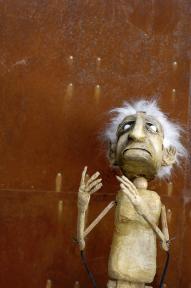The Toronto Plank Panel observe some famous puppet death scenes

Your Plank Panel with no strings attached includes:
Sarah Baumann is a Toronto-based director and the co-founder and artistic director of Theatre Smash.
Alison Broverman is a Toronto-based playwright and freelance arts reporter.
Ann McDougall is a Toronto-based writer and storyteller.
The Play: Famous Puppet Death Scenes by the Old Trout Puppet Workshop at The Young Centre for the Performing Arts.
Alison: I don't know if it's a result of my Sesame Street-obsessed youth, or just good old adult-onset ADHD, but I love a show that's made up of a bunch of short vignettes. If you don't like what you're watching, it's over in a couple of minutes and on to the next. The Old Trouts make particularly good use of this format, I think, by using different segments to play with different styles of puppets. The running gag that opens and closes the show is great too, and I'm just a sucker for that Edward Gorey-esque tone that pervades the entire thing.
Ann: I like the vignettes because I feel like I'm at a Futurist cabaret in the '20's! It also works really well here because the show hinges on the cleverness of its gags. I like how fearlessly they include bits that are slightly abstract through to downright weird. Nothing lingers long enough onstage to really alienate the audience, and as a result you get things that you would never see onstage elsewhere. Famous Puppet Death Scenes is absolutely unique, and that's pretty rare and special in the theatre.
Sarah: Usually I am a sucker for all things dark and bizarre (see: Norway.Today, the suicidal romantic comedy I just directed) however it was precisely the lack of story-throughline that kept me from becoming completely engaged with Famous Puppet Death Scenes. But kudos to this company for really doing something different. I find we all like to talk about doing just that but few of us actually go for it. AND the design of the whole thing is stunning. Is it just me or did one of the closing puppets look like E.T.?
Alison: Yes, that one puppet was very E.T.-looking. I found the show engaging, albeit in a different way from something with a narrative throughline. And of course some of the scenes were very silly - gallows humour or silly puppets you don't get too emotionally attached to (not that that's necessarily a bad thing: one of my favourite bits was that like a bizarre German kids show. "Ja, Bipsy. Ja.") But there were a few scenes that were quite moving in their sweet, small way. And the 'host' of the evening - he was heartbreaking.
Ann: Oh, poor Bipsy! I adore how cheerfully gross this show was - lots of blood and gore. I also really like how it pushed a little on the definition of puppetry. There was that one really lovely scene near the end where the 'puppet' was simply the full-sized body of a very old woman, and the puppeteer didn't actually manipulate it at all. He simply walked up and touched her as one actor would another. It's a haunting moment, because the puppet, of course, isn't alive, and we're forced to wonder if it is, then, dead. It makes the audience aware that the life which we animate puppets is the same life we give to our memories of departed loved ones. Pretty eloquent statement for a 60-second play with no text.
Sarah: My favourite scenes included the one with the pop up storybook where we got closer and closer to the action as the pages were turned. Brilliant. And the butterfly that we got a close up of every time the magnifying glass was raised to it. Although, given the nature of the show, I thought the magnifying glass was going to serve as a way to fry the butterfly. It would have been interesting to be a fly on the wall of this rehearsal process. I wonder how many vignettes were tried and discarded, and whether whole storylines for the fake plays exist in the minds of the creators?



